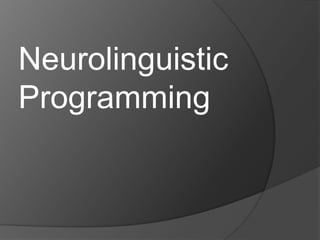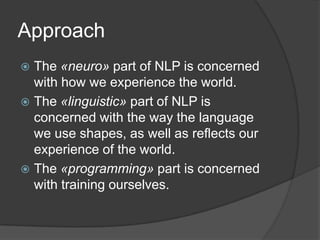Neurolinguistic programming
- 2. Background Neurolinguistic programming (NLP) is a training philosophy. Grinder and Bandler were interested in how people influenced each other. They studied successful therapists. Grinder and Bandler developed NLP as a system of techniques. They sought to fill a gap in psychological thinking. NLP was not developed with any applications to language teaching in mind.
- 3. Approach The «neuro» part of NLP is concerned with how we experience the world. The «linguistic» part of NLP is concerned with the way the language we use shapes, as well as reflects our experience of the world. The «programming» part is concerned with training ourselves.
- 4. Design
- 5. Outcomes The goals or ends. «Start with the end in mind» Human beings act as goal achieving systems.
- 6. 6 steps Be positive of what you want. How will you know when you have got it? Can this goal be started and maintained by you? Chunk-size. Specifically…when, where and how do you want this? Conceptualize resources.
- 7. Rapport Maximizing similarities and minimizing differences between people at a non- conscious level. It is the ability to create a sense of trust by making people feel that you are like them. It is meeting others in their world.
- 8. How to establish rapport? a) I hate this stuff. It´s just a waste of time. b) Everyone says that. It makes me sick. c) I can´t do it! d) This is all theory.
- 9. How to establish rapport? a) Is a part of you saying that you want to be sure your time is well spent today? b) Who says that? c) What, specifically, can´t you do? d) Are you saying you want practical suggestions?
- 10. Sensory acuity Use your senses. Look at, listen to, feel what is actually happening.
- 11. Flexibility Keep changing what you do until you get what you want.
- 12. The presuppositions of NLP 1. Mind and body are interconnected. 2. The map is not the territory. 3. There is no failure, only feedback… and a renewed opportunity for success. 4. The map becomes the territory. 5. Knowing what you want helps you get it. 6. The resources we need are with us.
- 13. 7. Communication is non-verbal as well as verbal. 8. The non-conscious mind is benevolent. 9. Communication is non-conscious as well as conscious. 10. All behavior has a positive intention. 11. The meaning of your communication is the response you get 12. Modelling excellent behavior leads to excellence. 13. In any system, the element of greatest flexibility will have the most influence on that system.
- 14. Procedure NLP principles can be applied to the teaching of all aspects of language. 1. Inner grammatical experience as you eat a biscuit. 2. Check vocabulary. 3. Students are asked to relax and «go inside». 4. Ask the students how they are feeling now.
- 15. 5. Say again the sentence. 6. Put a piece of paper on the wall with the words «I´ve eaten a biscuit» 7. On other pieces of paper, write sentences such as: I´ve painted a picture. I´ve had a row with my boy/girlfriend. I´ve finished my homework. I´ve cleaned my teeth. 8. Contrast the feeling of the present perfect with the feeling of the simple past. 9. Ask them to say the sentence «Yesterday, I ate a biscuit»
- 16. A few quick definitions The art and science of communication. The key to learning. It is the route to get the results you want. Influencing others with integrity. A manual for your brain. NLP helps people make sense of their reality. The toolkit for personal and organizational change. NLP is the study of internal experiences: how our thoughts, actions and feelings work together to produce our experience.
- 17. Stress The Truine Brain Theory. It divides the brain into three functional parts: Neocortex Limbic System Reptilian part
- 19. Concluding remarks NLP is a humanistic philosophy and a set of beliefs and suggestions. Workshops on NLP are typically short on theory and research to justify its claims. The assumptions of NLP need not be accepted as the absolute truth.


















